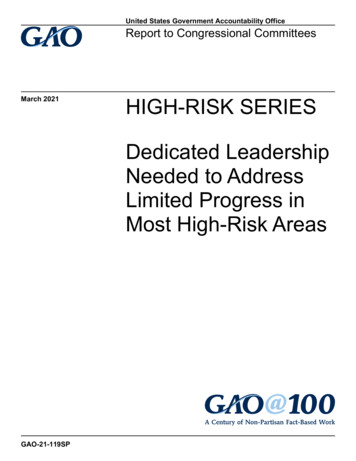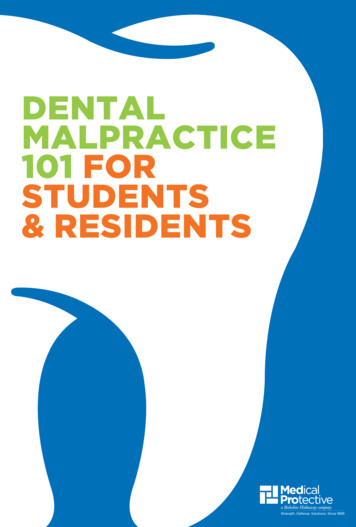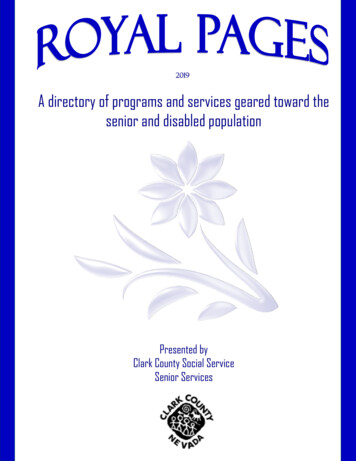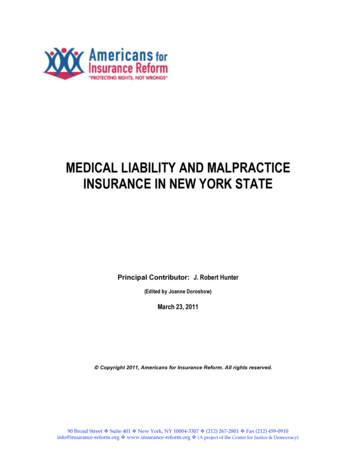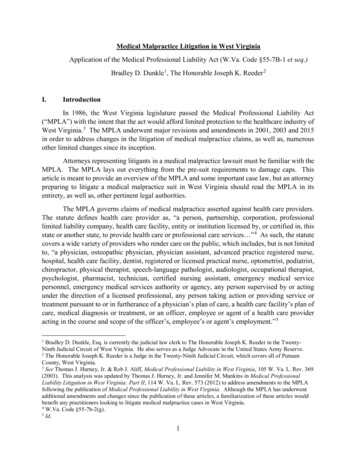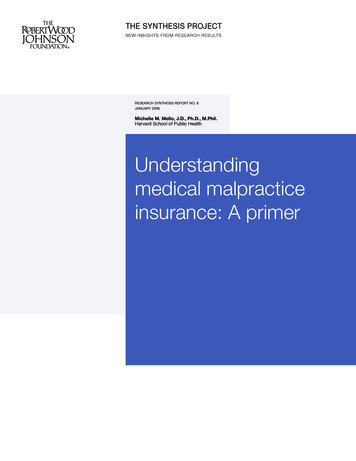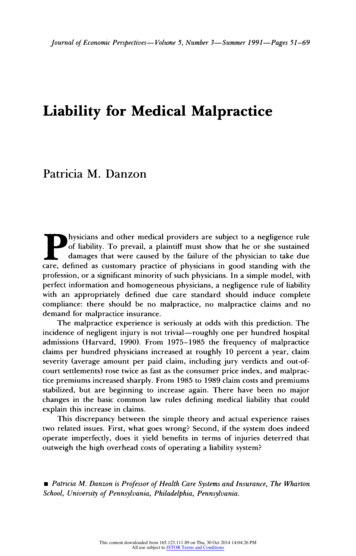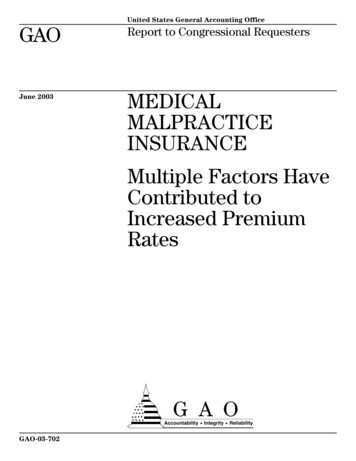
Transcription
United States General Accounting OfficeGAOReport to Congressional RequestersJune 2003MEDICALMALPRACTICEINSURANCEMultiple Factors HaveContributed toIncreased PremiumRatesGAO-03-702a
June 2003MEDICAL MALPRACTICE INSURANCEHighlights of GAO-03-702, a report tocongressional requestersMultiple Factors Have Contributed toIncreased Premium RatesOver the past several years, largeincreases in medical malpracticeinsurance premium rates haveraised concerns that physicians willno longer be able to affordmalpractice insurance and will beforced to curtail or discontinueproviding certain services.Additionally, a lack of profitabilityhas led some large insurers to stopselling medical malpracticeinsurance, furthering concerns thatphysicians will not be able toobtain coverage. To help Congressbetter understand the reasonsbehind the rate increases, GAOundertook a study to (1) describethe extent of the increases inmedical malpractice insurancerates, (2) analyze the factors thatcontributed to those increases, and(3) identify changes in the medicalmalpractice insurance market thatmight make this period of risingpremium rates different fromprevious such periods.Since 1999, medical malpractice premium rates have increased dramaticallyfor physicians in some specialties in a number of states. However, amonglarger insurers in the seven states GAO analyzed, both the premium ratesand the extent to which these rates have increased varied greatly (seefigure).GAO is not recommendingexecutive action. However, tofurther the understanding ofconditions in current and futuremedical malpractice markets,Congress may wish to considerencouraging the NationalAssociation of InsuranceCommissioners and state insuranceregulators to identify and collectadditional, mutually beneficial datanecessary for evaluating themedical malpractice insurancemarket.GAO’s analysis also showed that the medical malpractice market haschanged considerably since previous hard markets. Physician-owned and/oroperated insurers now cover around 60 percent of the market, self-insurancehas become more widespread, and states have passed laws designed toreduce premium rates. As a result, it is not clear how premium rates mightbehave during future soft or hard markets.Multiple factors, including falling investment income and rising reinsurancecosts, have contributed to recent increases in premium rates in our samplestates. However, GAO found that losses on medical malpractice claims—which make up the largest part of insurers’ costs—appear to be the primarydriver of rate increases in the long run. And while losses for the entireindustry have shown a persistent upward trend, insurers’ loss experienceshave varied dramatically across our sample states, resulting in widevariations in premium rates. In addition, factors other than losses can affectpremium rates in the short run, exacerbating cycles within the medicalmalpractice market. For example, high investment income or adjustmentsto account for lower than expected losses may legitimately permit insurersto price insurance below the expected cost of paying claims. However,because of the long lag between collecting premiums and paying claims,underlying losses may be increasing while insurers are holding premiumrates down, requiring large premium rate hikes when the increasing trend inlosses is recognized. While these factors may explain some events in themedical malpractice market, GAO could not fully analyze the compositionand causes of losses at the insurer level owing to a lack of comprehensivedata.Medical Malpractice Premium Base Rates for Obstetricians and Gynecologists Quoted byLarger Insurers in 1998 and 2002 in the Seven States GAO Visited (Dollars in Thousands)25020120014214015010310050959276643734 .To view the full product, including the scopeand methodology, click on the link above.For more information, contact Richard J.Hillman at (202) 512-8678 nia)1998FPIC(DadeCounty,Florida)FPIC(rest ofFlorida)MMICMACM(Minnesota) (Mississippi)2002Source: GAO analysis of annual surveys by the Medical Liability lphia, (El Paso,Pennsylvania) Texas)
ContentsLetter136Results in BriefBackgroundBoth the Extent of Increases in Medical Malpractice Premium Ratesand the Rates Themselves Varied across Specialties and StatesMultiple Factors Have Contributed to the Increases in MedicalMalpractice Premium RatesThe Medical Malpractice Insurance Market Has Changed sincePrevious Hard MarketsConclusionsMatter for Congressional ConsiderationNAIC Comments and Our Evaluation37434646Scope and Methodology49Legal Summary51State SummariesMarket DescriptionInsurer Characteristics and Market ShareRate RegulationState Tort Laws5555565657GAO Contacts and Staff AcknowledgmentsGAO ContactsAcknowledgments666666915AppendixesAppendix I:Appendix II:Appendix III:Appendix IV:Related GAO ProductsTablesFigures67Table 1: Annual Yields for Selected Bonds, 1995–2002, and AverageReturn on Investment Assets, 1997–2002, for the 15 LargestWriters of Medical Malpractice Insurance in 2001Table 2: Hypothetical Example of How Premium Rates ChangeWhen the Return on Investments FallsFigure 1: Premium Base Rates of the Largest Insurers in SevenSelected States for Three Medical Specialties,1992–2002Page i252711GAO-03-702 Medical Malpractice Insurance
ContentsFigure 2: Percentage Changes in Premium Base Rates of theLargest Medical Malpractice Insurers in Seven SelectedStates for Three Medical Specialties, 1999–2002Figure 3: 2002 Medical Malpractice Insurance Premium Base Ratesof the Largest Insurers in Seven Selected States for ThreeMedical SpecialtiesFigure 4: Inflation-Adjusted Paid and Incurred Losses for theNational Medical Malpractice Insurance Market, 1975–2001 (Using the CPI, in 2001 Dollars)Figure 5: Inflation-Adjusted Aggregate Paid Losses for MedicalMalpractice Insurers in Seven Selected States, 1975-2001(Using the CPI, in 2001 Dollars)Figure 6: Inflation-Adjusted Aggregate Incurred Losses for MedicalMalpractice Insurers in Seven Selected States, 1975-2001(Using the CPI, in 2001 Dollars)Figure 7: Net Profit or Loss as a Percentage of Net Worth forMedical Malpractice Insurance Companies Nationwide,1990–2001Figure 8: Aggregate Incurred Losses as a Percentage of PremiumsEarned for Medical Malpractice Insurers in SevenSelected States, 1975–2001Figure 9: Incurred Losses as a Percentage of Premium Income forMedical Malpractice Insurers and Property-CasualtyInsurers Nationwide, 1976–2001Figure 10: CaliforniaFigure 11: FloridaFigure 12: MinnesotaFigure 13: MississippiFigure 14: NevadaFigure 15: PennsylvaniaFigure 16: TexasPage ii121417192129303459606162636465GAO-03-702 Medical Malpractice Insurance
MATMLTAmerican Medical AssociationCooperative of American Physicians/Mutual Protection TrustCalifornia Department of InsuranceConsumer Price IndexDepartment of InsuranceFlorida Medical AssociationFirst Professionals Insurance CompanyJoint Underwriting AssociationMedical Assurance Company of MississippiMedical Insurance Exchange of CaliforniaMedical Inter-Insurance ExchangeMedical Liability MonitorMidwest Medical Insurance CompanyNational Association of Insurance CommissionersNevada Mutual Insurance CompanyNational Conference of State LegislaturesPhysician Insurers Association of AmericaPennsylvania Insurance DepartmentPennsylvania Medical Society Liability InsuranceCompanySouthern California Physicians Insurance ExchangeTexas Medical AssociationTexas Medical Liability TrustThis is a work of the U.S. government and is not subject to copyright protection in theUnited States. It may be reproduced and distributed in its entirety without furtherpermission from GAO. However, because this work may contain copyrighted images orother material, permission from the copyright holder may be necessary if you wish toreproduce this material separately.Page iiiGAO-03-702 Medical Malpractice Insurance
AUnited States General Accounting OfficeWashington, D.C. 20548June 27, 2003LertCongressional RequestersSince the late 1990s, premium rates for medical malpractice insurance haveincreased dramatically for physicians in certain specialties and states.1These increases have raised concerns that many physicians will no longerbe able to afford malpractice insurance and may be forced to curtail ordiscontinue providing services. These concerns have been heightened assome large insurers, faced with declining profits, have either stoppedselling medical malpractice insurance or reduced their operations in anumber of states. But disagreement exists over the causes of increasedpremium rates and what, if anything, should be done in response to thecurrent situation. For example, some have argued for tort reform as ameans of lowering certain awards in medical malpractice lawsuits andadvocate legislative changes at the state level designed to place a cap onsuch awards. Others have argued for medical reforms as a means ofreducing the incidence of medical malpractice or for insurance reforms asa way to moderate premium rate increases.In response to these concerns, you asked us to determine the reasonsbehind the recent increases in some medical malpractice insurance rates.2Our specific objectives were to (1) describe the extent of the increases inmedical malpractice insurance rates, (2) analyze the factors that havecontributed to the increases, and (3) identify changes in the medicalmalpractice insurance market that may make the current period of risingpremium rates different from earlier periods of rate hikes. We will also1Medical malpractice lawsuits are generally based on tort law, which includes both statutesand court decisions. A tort is a wrongful act or omission by an individual that causes harmto another individual. Typically, a malpractice tort would be based on the claim that thehealth care provider was negligent, had failed to meet the acceptable standard of care owedto the patient, and thus had caused injury to the patient.2Some health care provider associations and others have expressed concern over medicalmalpractice insurance premium rates for nursing homes and hospitals, but this topic isoutside the scope of our report.Page 1GAO-03-702 Medical Malpractice Insurance
issue a related report that describes the effect of rising malpracticepremiums on access to health care and related issues.3Recognizing that the medical malpractice market can vary considerablyacross states, as part of our review we judgmentally selected a sample ofseven states—California, Florida, Minnesota, Mississippi, Nevada,Pennsylvania, and Texas—in order to conduct a more in depth review ineach of those states. Our sample contains a mix of states based on thefollowing characteristics: extent of any recent increases in premium rates,status as a “crisis state” according to the American Medical Association,presence of caps on noneconomic damages, state population, andaggregate loss ratios for medical malpractice insurers within the state.Except where noted otherwise, our analyses were limited to these states.Within each state, we spoke to one or both of the two largest and currentlyactive medical malpractice insurers,4 the state insurance regulator, and thestate association of trial attorneys. In six states, we spoke to the statemedical association, and in five states, we spoke to the state hospitalassociation. To examine the extent of increases in medical malpracticeinsurance rates in our sample states, we reviewed annual survey datacollected by a private company.5 To analyze the factors contributing to thepremium rate increases in our sample states as well as nationally, wereviewed data provided by medical malpractice insurers to state insuranceregulators, the National Association of Insurance Commissioners (NAIC),63For other related GAO products, see the list at the end of this report.4We determined the largest insurers in 2002 based on premiums written for calendar year2001.5The Medical Liability Monitor annually surveys providers of medical malpracticeinsurance to obtain their premium base rates for three different specialties: internalmedicine, general surgery, and obstetrics/gynecology.6NAIC is a voluntary association of the heads of each state insurance department, theDistrict of Columbia, and four U.S. territories. NAIC assists state insurance regulators byproviding guidance, model (or recommended) laws and guidelines, and information-sharingtools.Page 2GAO-03-702 Medical Malpractice Insurance
and A.M. Best7 on insurers within our sample states as well as the 15 largestwriters of medical malpractice insurance nationally in 2001 (whosecombined market share nationally was approximately 64.3 percent). Wealso spoke with officials from professional actuarial and insuranceorganizations and national trial attorney and medical associations andreviewed their testimonies before Congress. In addition, we analyzed dataon medical malpractice claims collected by insurers, state regulators, andothers in our sample states as well as nationally.To analyze how the national medical malpractice insurance market haschanged since previous periods of rising premium rates, we reviewedstudies published by NAIC, reviewed state insurance regulations and tortlaws, and spoke to the insurers and state insurance departments in oursample states. We also spoke to officials from national professionalactuarial, legal, and insurance organizations. Appendix I contains a moredetailed description of our methodology.Results in BriefSince 1999, medical malpractice premium rates for physicians in somestates have increased dramatically. Among the seven states that weanalyzed, we found that both the extent of the increases and the premiumlevels varied greatly not only from state to state but across medicalspecialties and even among areas within states. For example, the largestwriter of medical malpractice insurance in Florida increased premiumrates for general surgeons in Dade County by approximately 75 percentfrom 1999 to 2002, while the largest insurer in Minnesota increasedpremium rates for the same specialty by about 2 percent over the sameperiod. The resulting 2002 premium rate quoted by the insurer in Floridawas 174,300 a year, more than 17 times the 10,140 premium rate quotedby the insurer in Minnesota. In addition, the Florida insurer quoted a ratefor general surgeons outside Dade County of 89,000 a year for the samecoverage, approximately 51 percent of the rate it quoted inside DadeCounty.7A.M. Best is a rating agency that provides current or prospective investors, creditors, andpolicyholders with independent analyses of insurance companies’ overall financial strength,creditworthiness, ability to pay claims, and company activities.Page 3GAO-03-702 Medical Malpractice Insurance
Multiple factors have contributed to the recent increases in medicalmalpractice premium rates in the seven states we analyzed. First, since1998 insurers’ losses on medical malpractice claims have increased rapidlyin some states. For example, in Mississippi the amount insurers paidannually on medical malpractice claims, or paid losses,8 increased byapproximately 142 percent from 1998 to 2001 after adjusting for inflation.9We found that the increased losses appeared to be the greatest contributorto increased premium rates, but a lack of comprehensive data at thenational and state levels on insurers’ medical malpractice claims and theassociated losses prevented us from fully analyzing the composition andcauses of those losses. For example, data that would have allowed us toanalyze claim severity at the insurer level on a state-by-state basis ordetermine how losses were broken down between economic andnoneconomic damages were unavailable. Second, from 1998 through 2001medical malpractice insurers experienced decreases in their investmentincome10 as interest rates fell on the bonds that generally make up around80 percent of these insurers’ investment portfolios. While almost nomedical malpractice insurers experienced net losses on their investmentportfolios over this period, a decrease in investment income meant thatincome from insurance premiums had to cover a larger share of insurers’costs. Third, during the 1990s insurers competed vigorously for medicalmalpractice business, and several factors, including high investmentreturns, permitted them to offer prices that in hindsight, for some insurers,did not completely cover their ultimate losses on that business. As a resultof this, some companies became insolvent or voluntarily left the market,reducing the downward competitive pressure on premium rates that hadexisted through the 1990s. Fourth, beginning in 2001 reinsurance rates formedical malpractice insurers also increased more rapidly than they had in8Paid losses are the cash payments insurers made in a given period, such as a calendar year,on claims reported during both the current and previous years. Incurred losses include theinsurer’s expected costs for claims reported in that year and adjustments to the expectedcosts for claims reported in earlier years. In Mississippi, insurers’ incurred losses increasedapproximately 197.5 percent from 1998 to 2001, after adjusting for inflation.9We adjusted for inflation using the consumer price index (CPI). The CPI is a measure of theaverage change over time in the prices consumers pay for a basket of goods and services.This report uses the CPI-U, which is meant to reflect the spending patterns of urbanconsumers and covers about 87 percent of the total U.S. population.10In general, state insurance regulators require insurers to reduce their requested premiumrates in line with expected investment income. That is, the higher the expected income frominvestments, the more premium rates must be reduced.Page 4GAO-03-702 Medical Malpractice Insurance
the past, raising insurers’ overall costs.11 In combination, all of thesefactors contribute to the movement of the medical malpractice insurancemarket through cycles of hard and soft markets--similar to thoseexperienced by the property-casualty insurance market as a whole--duringwhich premium rates fluctuate.12 Cycles in the medical malpractice markettend to be more extreme than in other insurance markets because of thelonger period of time required to resolve medical malpractice claims, andfactors such as changes in investment income and reduced competition canexacerbate the fluctuations.While the medical malpractice insurance market as a whole hadexperienced periods of rapidly increasing premium rates during previoushard markets in the mid-1970s and mid-1980s, the market has changedconsiderably since then. These changes are largely the result of actionsinsurers, health care providers, and states have taken to address increasingpremium rates. Beginning in the 1970s and 1980s, insurers began selling“claims-made” rather than “occurrence-based” policies,13 enabling insurersto better predict losses for a particular year. Also in the 1970s, physicians,facing increasing premium rates and the departure of some insurers, beganto form mutual nonprofit insurance companies. Such companies, whichmay have some cost and other advantages over commercial insurers, nowcomprise a significant portion of the medical malpractice insurancemarket. More recently, an increasing number of large hospitals and groupsof hospitals or physicians have left the traditional commercial insurancemarket and begun to insure themselves in a variety of ways—for example,by self-insuring. While such arrangements can save money onadministrative costs, hospitals and physicians insured through thesearrangements assume greater financial responsibility for malpracticeclaims than they would under traditional insurance arrangements and thusmay face a greater risk of insolvency. Finally, since periods of increasing11Reinsurance is insurance for insurance companies, which insurance companies routinelyuse as a way to spread the risk associated with their insurance policies.12Some industry officials have characterized hard markets as periods of rapidly risingpremium rates, tightened underwriting standards, narrowed coverage, and the withdrawalof insurers from certain markets. Soft markets are characterized by relatively flat or slowrising premium rates, less stringent underwriting standards, expanded coverage and strongcompetition among insurers.13Claims-made policies cover claims reported during the year in which the policy is in effect.Occurrence-based policies cover claims arising out of events that occurred but may nothave been reported during the year in which the policy was in effect. Most policies soldtoday are claims-made policies.Page 5GAO-03-702 Medical Malpractice Insurance
premium rates during the mid-1970s and mid-1980s, all states passed atleast some laws designed to reduce medical malpractice premium rates.Some of these laws are designed to decrease insurers’ losses on medicalmalpractice claims, while others are designed to more tightly control thepremium rates insurers can charge. These changes make it difficult topredict how medical malpractice premiums might behave during futurehard and soft markets.This report includes a matter that Congress may want to consider as itlooks for ways to improve the ability of Congress, state insuranceregulators, and others to analyze the current and future medicalmalpractice insurance markets. Specifically, Congress may want toconsider encouraging NAIC and state insurance regulators to identify andcollect additional data necessary to evaluate the frequency,14 severity,15 andcauses of losses on medical malpractice claims.We received comments on a draft of this report from NAIC’s Director ofResearch. The Director generally agreed with the report’s findings andmatters for congressional consideration, and provided technical commentsthat we have incorporated as appropriate. The Director’s comments arediscussed in greater detail at the end of this letter.BackgroundNearly all health care providers, such as physicians and hospitals, purchaseinsurance that covers expenses related to medical malpractice claims,including payments to claimants and legal expenses. The most commonphysician policies provide 1 million of coverage per incident and 3 million of coverage per year. Today the primary sellers of physicianmedical malpractice insurance are the physician-owned and/or operatedinsurance companies that, according to the Physician Insurers Associationof America, insure approximately 60 percent of all physicians in privatepractice in the United States. Other health care providers may obtaincoverage through commercial insurance companies, mutual coveragearrangements, or state-run insurance programs, or may self-insure (takeresponsibility for claims themselves). Most medical malpractice insurancepolicies offer claims-made coverage, which covers claims reported during14Claim frequency is the number of claims per exposure unit, such as a single generalpractitioner.15Claim severity is the average loss per claim.Page 6GAO-03-702 Medical Malpractice Insurance
the year in which the policy is in effect. A small and declining number ofpolicies offer occurrence coverage, which covers all claims arising out ofevents that occurred during the year in which the policy was in effect.Medical malpractice insurance operates much like other types ofinsurance, with insurers collecting premiums from policyholders inexchange for an agreement to defend and pay future claims within thelimits set by the policy. Insurers invest the premiums they collect and usethe income from those investments to reduce the amount of premiumincome that would have been required otherwise. Claims against apolicyholder are recorded as expenses, or incurred losses, which are equalto the amount paid on those claims as well as the insurer’s estimate offuture losses on those same claims. The liability associated with theportion of these incurred losses that have not yet been paid by the insureris collectively known as the insurer’s loss reserve. In order to maintainfinancial soundness, insurers must maintain assets in excess of totalliabilities—including loss reserves and reserves for premiums received butnot yet earned16—to make up what is known as the insurer’s surplus. Stateinsurance departments monitor insurers’ solvency by tracking, amongother measures, the ratio of total annual premiums to this surplus. Medicalmalpractice insurers generally attempt to keep their surplus approximatelyequal to their annual premium income.Medical malpractice insurers establish premium base rates for particularmedical specialties within a state and sometimes for particular geographicregions within a state. Insurers may also offer discounts or add surchargesfor the particular characteristics of policyholders, such as claim historiesor whether they participate in risk-management programs. The premiumrates are based on anticipated losses on claims and related expenses,expected investment income, the need to build a surplus, and, for for-profitinsurers, the desire to earn a reasonable profit for shareholders. In moststates the insurance regulators have the authority to approve or denyproposed changes to premium rates.16Insurers collect premiums in advance for coverage during a future period of time, and asthat period of time passes, those premiums are “earned.” Premiums related to periods oftime yet to pass are considered “unearned” and are a liability on the books of the insurer.Page 7GAO-03-702 Medical Malpractice Insurance
For several reasons, accurately predicting losses on medical malpracticeclaims is difficult. First, according to a national insurer association wespoke with, most medical malpractice claims take an average of more than5 years to resolve, including discovering the malpractice, filing a claim,determining (through settlement or trial) payment responsibilities, if any,and paying the claim.17 In addition, some claims may not be resolved for aslong as 8 to 10 years. As a result, insurers often must estimate costs years inadvance. Second, the range of potential losses is wide. Actuaries we spokewith told us that individual claims with similar characteristics can result invery different losses for the insurer, making it difficult to predict theultimate cost of any single claim. Third, the predictive value of historicaldata is further limited by the often small pool of relevant policyholders. Forexample, a relevant pool of policyholders would be physicians practicing aparticular specialty within a specific state and perhaps within a specificgeographic area within that state. In smaller states, and for some of the lesscommon but more risky specialties, this pool could be very small andprovide only a limited amount of data that could be used to estimate futurecosts.Medical malpractice insurance is regulated by state insurance departmentsand subject to state laws. That is, insurers selling medical malpracticeinsurance in a particular state are subject to that state’s regulations fortheir operations within that state, and all claims within that state aresubject to that state’s tort laws. Insurance regulations can vary acrossstates, creating differences in the way insurance rates are regulated. Forexample, one state insurance regulator we spoke with essentially let theinsurance market determine appropriate rates, while another had anincreased level of review, including approving specific company rates on acase-by-case basis. NAIC assists state insurance regulators in developingthese regulations by providing guidance, model (or recommended) lawsand guidelines, and information-sharing tools.In response to concerns over rising premium rates, physicians, medicalassociations, and insurers have pushed for state and federal legislation thatwould, among other things, limit the amount of damages paid out onmedical malpractice claims. A few states have passed legislation with suchlimitations over the past several years, and federal legislation is pending.On March 13, 2003, the House of Representatives passed the Help Efficient,17Estimates of some individual insurers we spoke with ranged from around 3 years to over5 years.Page 8GAO-03-702 Medical Malpractice Insurance
Accessible Low-Cost, Timely Healthcare (HEALTH) Act of 2003, whichincludes, among other things, a limit on certain types of damages inmedical malpractice claims. On March 12, 2003, a similar bill of the samename was introduced in the Senate, but as of June 2003, no additionalaction had been taken.Both the Extent ofIncreases in MedicalMalpractice PremiumRates and the RatesThemselves Variedacross Specialties andStatesBeginning in 1999 and 2000, medical malpractice insurers in our sevensample states increased their premium rates18 for the physician specialtiesof general surgery, internal medicine, and obstetrics/gynecology faster thanthey had since at least 1992. These specialties were the only ones for whichdata were available, and 1992 was the earliest year for which we couldobtain comprehensive survey data.19 However, both the extent of thesechanges and the level of the premium rates insurers charged varied greatlyacross medical specialties, states, and even areas within states. From 1999through 2002, one large insurer raised rates more for internal medicinethan for general surgery, while another raised rates 12 times more forgeneral surgery than for internal medicine. Changes in premium base ratesamong some of the largest insurers in each state ranged from a reduction ofabout 9 percent for obstetricians and gynecologists insured by oneCalifornia company to an increase of almost 170 percent for doctors in the18In this report, premium rates are the base rates insurers submit to state regulators alongwith a schedule of potential deductions or additions
Since the late 1990s, premium rates for medical malpractice insurance have increased dramatically for physicians in certain specialties and states.1 These increases have raised concerns that many physicians will no longer be able to afford malpractice insurance and may be forced to curtail or discontinue providing services.

